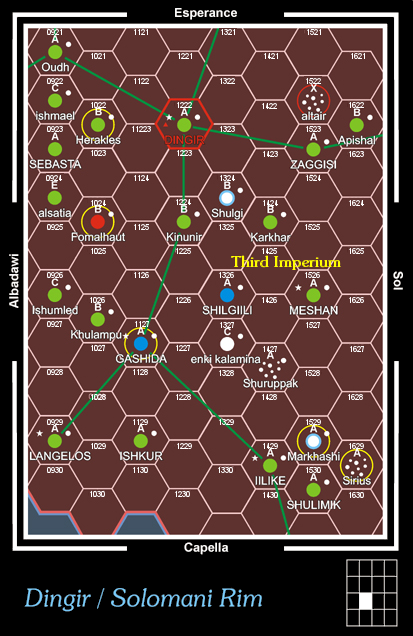Dingir Subsector
| Dingir Subsector | |
|---|---|
 | |
| Sector | Solomani Rim |
| Capital | Dingir |
| No. of Stars | 26 |
| Majority Control | Imperium - 100% |
| Map Key | Map Key |
Dingir Subsector is subsector J of the Solomani Rim Sector.
Description (Specifications)
The Dingir Subsector is defended by 115th Fleet.
Subsector Summary: 1116
Dingir, subsector J of Solomani Rim contains 26 worlds with an estimated population of 151 billion, a per capita income of Cr13,384, and a total economy is BCr2,021,048. These worlds originate an interstellar trade of BCr38,020 through 24 starports (14 Class A, 7 Class B, 3 Class C, 0 Class D) employing 8,258,470 people. Driving this interstellar trade are two Agricultural (Ag) worlds, six Non-Agricultural (Na) worlds, no Pre-Agricultural (Pa) worlds, five Pre-Industrial (Pi) worlds, no Rich (Ri) worlds, and three Industrial (In) worlds. The governments in Dingir maintain five Naval bases, and one Way station. The average technology level is 11 (with most between 8 and 14). The highest technology level is 15 at Sebasta (Solomani Rim 0923), Langelos (Solomani Rim 0929), and Dingir (Solomani Rim 1222).
Dingir, subsector J of Solomani Rim contains 35 stars and 299 identified planets; 18 monostellar systems, seven binary systems, one trinary system, and no systems with four or more stars. 22 of the 26 systems (84%) have native gas giants. There are three Asteroid (As) belts, no Desert (De) worlds, one Garden (Ga) world, two Ice-capped (Ic) worlds, five Poor (Po) worlds, five Vacuum (Va) worlds, and two Water (Wa) or Ocean (Oc) worlds.
Dingir has an estimated population of 151 billion distributed across ten High population (Hi) worlds, three Moderate population (Ph) worlds, four Non-industrial (Ni) worlds, three Low population (Lo) worlds, and one Barren (Ba) world. The highest population worlds are Sebasta (Solomani Rim 0923) and Dingir (Solomani Rim 1222). The population consists of 1 sophont groups.
| 1 identified sophont populations in Dingir | |
|---|---|
|
Third Imperium
The Third Imperium has jurisdiction over all of the worlds with an estimated population of 151 billion, a per capita income of Cr13,384, and a total economy is BCr2,021,048. These worlds originate an interstellar trade of BCr38,020 through 24 starports (14 Class A, 7 Class B, 3 Class C, 0 Class D) employing 8,258,470 people. Driving this interstellar trade are two Agricultural (Ag) worlds, six Non-Agricultural (Na) worlds, no Pre-Agricultural (Pa) worlds, five Pre-Industrial (Pi) worlds, no Rich (Ri) worlds, and three Industrial (In) worlds. The governments in Third Imperium maintain five Naval bases, and one Way station. The average technology level is 11 (with most between 8 and 14). The highest technology level is 15 at Sebasta (Solomani Rim 0923), Langelos (Solomani Rim 0929), and Dingir (Solomani Rim 1222).
The Third Imperium has an estimated population of 151 billion distributed across ten High population (Hi) worlds, three Moderate population (Ph) worlds, four Non-industrial (Ni) worlds, three Low population (Lo) worlds, and one Barren (Ba) world. The highest population worlds are Sebasta (Solomani Rim 0923) and Dingir (Solomani Rim 1222). The population consists of 1 sophont groups.
- The Third Imperium sector capital is Dingir (Solomani Rim 1222).
World Listing: 1116
The following systems and worlds can be found within this area:
Notes: Dingir Subsector contains 27 worlds including both worlds of the Fomalhaut (SR 1024) (system). Some T5SS astrographic maps omit the second world of Fomalhaut (SR 1024) (system).
- Fomalhaut (SR 1024) (system) contains two inhabitable worlds:
Astrographic Features & Trade Routes: 1116
The following astrographic features and trade routes can be found within this area:
History & Background (Dossier)
It was the scene of many of the battles in the Second through Seventh Interstellar Wars. Conquered early by Terra, its population is predominantly Solomani in heritage and sympathy, especially on such worlds as Iilike (Tau Ceti), Shulimik (Epsilon Eridani), and Gashidda.
- Dingir holds an important place in human history. It has been, in turn, a provincial capital for the First Imperium, headquarters for the Terran Confederation Fleet, for a brief time capital of the Rule of Man, capital of the Dingir League, a subsector capital for the Third Imperium and for the Solomani Confederation, and once again sector capital in the years following the Solomani Rim War.
Polity Listing: 1116
The following polities can be found within this subsector:
- Independent Powers
- None
- Non-Aligned Powers (World-States)
- None
- Other Powers
- Dingir League (past)
- Third Imperium
- Solomani Autonomous Region
- Various member systems and worlds.
Native Sophonts: 1116
The following races (sophont species) are believed to have originated in this area:
- Humaniti (Human races)
- None.
- Non-Human Races
- None.
- Terragens (Non-human Terran races)
- None.
Demographics: 1116
Significant populations of the following races (sophont species) reside within this area:
- Non-Human Races
- None.
- Terragens (Non-human Terran races)
- None.
Major Historical Events Timeline: 1116
These are some of the more important historical events that have affected this subsector:
References & Contributors (Sources)
| This article has a world list. |
This article is incomplete meaning it lacks important features, structure, or content. More work needs to be done to make this a good article. This is step 4. in the article refinement process.
|
- Classic Traveller Alien Module 6: Solomani
- Classic Traveller The Solomani Rim (Supplement 10)
- GURPS Traveller: Rim of Fire: The Solomani Rim Sourcebook
- Traveller: The New Era Traveller Chronicle 10